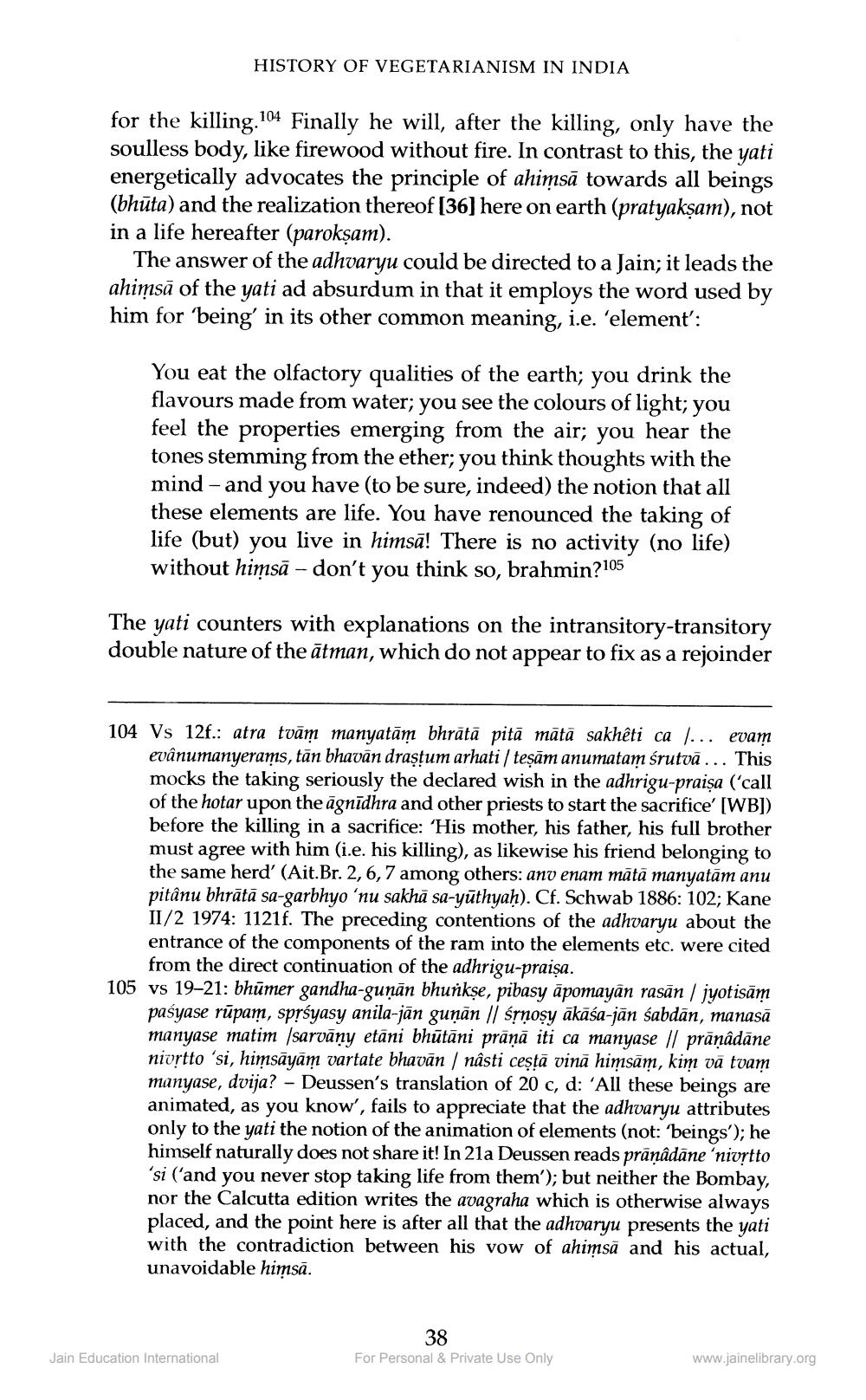________________
HISTORY OF VEGETARIANISM IN INDIA
for the killing. 104 Finally he will, after the killing, only have the soulless body, like firewood without fire. In contrast to this, the yati energetically advocates the principle of ahimsā towards all beings (bhūta) and the realization thereof [36] here on earth (pratyakşam), not in a life hereafter (parokşam).
The answer of the adhvaryu could be directed to a Jain; it leads the ahimsā of the yati ad absurdum in that it employs the word used by him for 'being in its other common meaning, i.e. 'element':
You eat the olfactory qualities of the earth; you drink the flavours made from water; you see the colours of light; you feel the properties emerging from the air; you hear the tones stemming from the ether; you think thoughts with the mind - and you have (to be sure, indeed) the notion that all these elements are life. You have renounced the taking of life (but) you live in himsā! There is no activity (no life) without himsā - don't you think so, brahmin?105
The yati counters with explanations on the intransitory-transitory double nature of the ātman, which do not appear to fix as a rejoinder
104 Vs 12f.: atra tvām manyatām bhrātā pitā mātā sakheti ca l... evam
evânumanyerams, tān bhavan drastum arhati / teşām anumatam śrutvā ... This mocks the taking seriously the declared wish in the adhrigu-praisa ('call of the hotar upon the agnīdhra and other priests to start the sacrifice' (WB]) before the killing in a sacrifice: 'His mother, his father, his full brother must agree with him (i.e. his killing), as likewise his friend belonging to the same herd' (Ait.Br. 2,6,7 among others: anv enam mātā manyatām anu pitânu bhrātā sa-garbhyo'nu sakha sa-yūthyah). Cf. Schwab 1886: 102; Kane II/2 1974: 1121f. The preceding contentions of the adhvaryu about the entrance of the components of the ram into the elements etc. were cited
from the direct continuation of the adhrigu-praisa. 105 vs 19–21: bhūmer gandha-guņān bhunkse, pibasy āpomayān rasān / jyotisām
paśyase rūpam, sprśyasy anila-jān guṇān // śļņosy ākāśa-jān sabdān, manasā manyase matim sarvany etāni bhūtāni prānā iti ca manyase // prānâdāne nivrtto 'si, hiņsāyām vartate bhavan / nâsti cestă vină himsām, kim vā tvam manyase, dvija? - Deussen's translation of 20 c, d: 'All these beings are animated, as you know', fails to appreciate that the adhvaryu attributes only to the yati the notion of the animation of elements (not: beings'); he himself naturally does not share it! In 21a Deussen reads pranâdāne'nivrtto 'si ('and you never stop taking life from them'); but neither the Bombay, nor the Calcutta edition writes the avagraha which is otherwise always placed, and the point here is after all that the adhvaryu presents the yati with the contradiction between his vow of ahimsa and his actual, unavoidable himsā.
38 For Personal & Private Use Only
Jain Education International
www.jainelibrary.org




